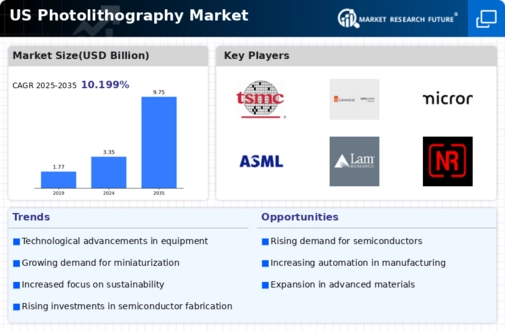The US Photolithography Market is characterized by intense competition among key players who provide advanced technologies essential for the manufacturing of semiconductors. This market is crucial for the fabrication of integrated circuits, where precision and innovation are paramount. Companies within this field are focusing on improving resolution capabilities, process efficiencies, and overall cost-effectiveness in response to the growing demands of the electronics industry. As the semiconductor market continues to expand, driven by trends such as the Internet of Things, 5G, and artificial intelligence, the photolithography segment is witnessing significant technological advancements aimed at maintaining competitive edges.
Additionally, partnerships, research and development investments, and strategic mergers and acquisitions play a critical role in shaping the competitive landscape, influencing pricing strategies and product offerings.
In the context of the US Photolithography Market, TSMC has established a formidable presence. Known for its leading-edge manufacturing capabilities, the company excels in providing advanced process nodes required for high-performance applications. TSMC’s strength lies in its robust ability to produce chips at smaller geometries, ensuring that it stays ahead in technology leadership. With a comprehensive portfolio of services ranging from design support to manufacturing, TSMC effectively caters to a diverse clientele. The firm has made extensive investments in expanding its manufacturing capacities in the US, thereby enhancing its operational footprint while aligning with local demand requirements.
The strategic focus on innovation and enhanced yield rates further solidifies TSMC’s competitive standing within this market.
Canon, on the other hand, has also carved out its niche in the US Photolithography Market with a focus on providing equipment for semiconductor manufacturing, primarily through its lithography systems. Canon's strengths are manifested through its innovative developments in optical technology, which is vital for patterning processes in chip fabrication. The company offers a range of products, including advanced lithography systems that cater to various sectors within the semiconductor industry. Canon's commitment to R&D, coupled with strategic mergers and acquisitions, has enabled it to enhance its technological capabilities and expand its market reach effectively.
Its established brand recognition and collaborations within the industry further augment its position in the U.S. market, allowing Canon to respond swiftly to the evolving landscape and maintain competitiveness in photolithography solutions.























Leave a Comment